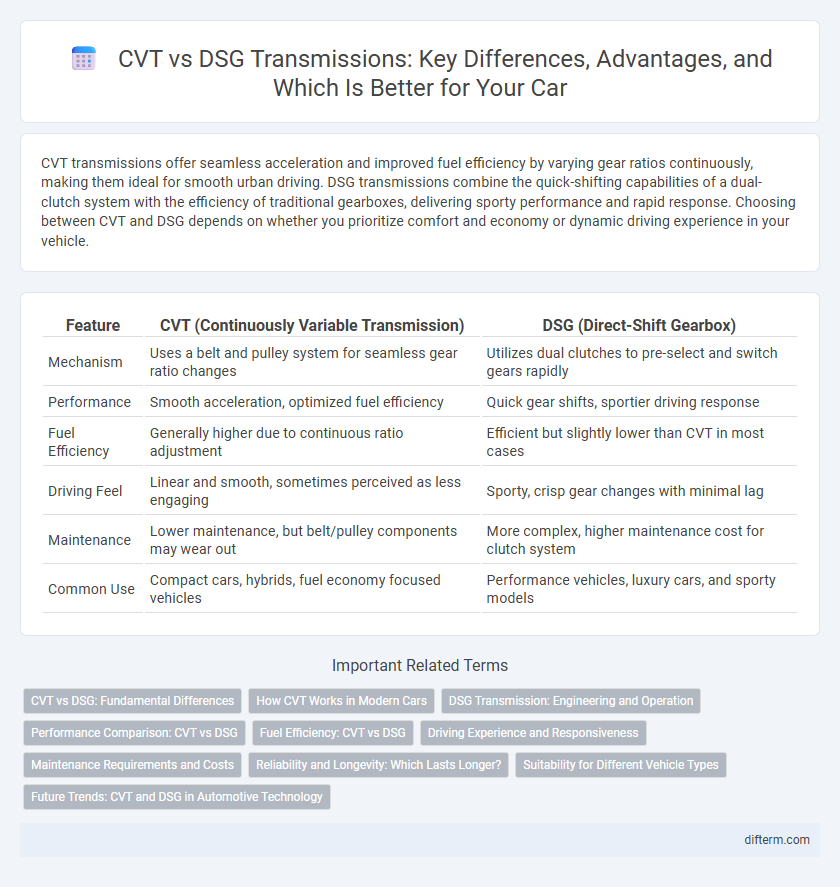CVT transmissions offer seamless acceleration and improved fuel efficiency by varying gear ratios continuously, making them ideal for smooth urban driving. DSG transmissions combine the quick-shifting capabilities of a dual-clutch system with the efficiency of traditional gearboxes, delivering sporty performance and rapid response. Choosing between CVT and DSG depends on whether you prioritize comfort and economy or dynamic driving experience in your vehicle.
Table of Comparison
| Feature | CVT (Continuously Variable Transmission) | DSG (Direct-Shift Gearbox) |
|---|---|---|
| Mechanism | Uses a belt and pulley system for seamless gear ratio changes | Utilizes dual clutches to pre-select and switch gears rapidly |
| Performance | Smooth acceleration, optimized fuel efficiency | Quick gear shifts, sportier driving response |
| Fuel Efficiency | Generally higher due to continuous ratio adjustment | Efficient but slightly lower than CVT in most cases |
| Driving Feel | Linear and smooth, sometimes perceived as less engaging | Sporty, crisp gear changes with minimal lag |
| Maintenance | Lower maintenance, but belt/pulley components may wear out | More complex, higher maintenance cost for clutch system |
| Common Use | Compact cars, hybrids, fuel economy focused vehicles | Performance vehicles, luxury cars, and sporty models |
CVT vs DSG: Fundamental Differences
CVT (Continuously Variable Transmission) offers seamless acceleration by using a belt and pulley system to provide an infinite range of gear ratios, optimizing fuel efficiency and smoothness. DSG (Direct-Shift Gearbox) employs dual clutches for rapid gear changes, delivering a sportier driving experience with minimal power loss and precise control. The fundamental difference lies in CVT's variable ratio mechanism for efficiency versus DSG's discrete gear sets for performance and responsiveness.
How CVT Works in Modern Cars
Continuously Variable Transmissions (CVT) in modern cars use a system of pulleys and a steel belt or chain to provide seamless gear ratio changes, optimizing engine performance and fuel efficiency. Unlike traditional gear-based transmissions like DSG (Direct Shift Gearbox), CVTs offer smooth acceleration without noticeable gear shifts, which enhances driving comfort and reduces mechanical complexity. Advanced software controls adjust the CVT's variable pulley angles in real-time, allowing precise power delivery and improved responsiveness in diverse driving conditions.
DSG Transmission: Engineering and Operation
DSG (Direct Shift Gearbox) transmission utilizes dual clutches to enable lightning-fast gear changes without interrupting engine power, enhancing both acceleration and fuel efficiency in modern vehicles. Its engineering involves two separate clutches for odd and even gear sets, allowing seamless pre-selection of the next gear, which results in smoother driving dynamics compared to conventional CVT systems. DSG technology combines the benefits of manual and automatic transmissions by providing precise control and quicker response times, favored in performance and sporty automotive applications.
Performance Comparison: CVT vs DSG
DSG transmissions deliver faster and more precise gear shifts compared to CVT, resulting in superior acceleration and sporty driving dynamics. CVT systems provide seamless and stepless gear ratios, optimizing fuel efficiency and smoothness but often compromising on responsiveness. Performance-oriented vehicles typically favor DSG for its direct power transfer and enhanced driver engagement.
Fuel Efficiency: CVT vs DSG
Continuously Variable Transmissions (CVT) typically offer superior fuel efficiency compared to Direct-Shift Gearboxes (DSG) due to their ability to maintain optimal engine speed without discrete gear steps. CVTs adjust seamlessly to driving conditions, reducing fuel consumption especially in city traffic and stop-and-go situations. DSGs provide quicker gear shifts and sportier performance, but their multiple gear sets and mechanical complexity often result in slightly higher fuel usage compared to CVTs.
Driving Experience and Responsiveness
CVT transmissions deliver smooth, seamless acceleration by continuously varying gear ratios, which enhances fuel efficiency but can result in a less engaging driving experience due to the lack of distinct gear shifts. DSG transmissions offer rapid, precise gear changes with dual-clutch technology, providing sporty responsiveness and immediate power delivery that appeals to driving enthusiasts. This results in a more dynamic and connected feel, especially in performance-oriented vehicles where quick shift response is crucial.
Maintenance Requirements and Costs
Continuously Variable Transmissions (CVT) typically demand regular fluid changes every 30,000 to 60,000 miles to prevent belt or pulley wear, which can be costly if neglected. Dual-Clutch Transmissions (DSG) require frequent transmission oil replacement and occasional clutch pack repairs, with maintenance intervals ranging from 40,000 to 60,000 miles. Overall, CVTs often incur higher long-term maintenance costs due to specialized fluid and belt wear, whereas DSGs may face more expensive clutch replacement but benefit from broader service availability.
Reliability and Longevity: Which Lasts Longer?
CVT (Continuously Variable Transmission) systems generally offer smoother acceleration but may experience faster wear in the belt and pulley components, leading to potential reliability issues over time. DSG (Direct Shift Gearbox) transmissions, with their dual-clutch design, tend to provide greater durability and longer service life when maintained properly, thanks to robust mechanical parts and efficient gear engagement. Statistically, DSG units often surpass CVTs in longevity, making them a preferred choice for drivers prioritizing reliability in automotive transmissions.
Suitability for Different Vehicle Types
CVT transmissions excel in fuel-efficient compact cars and hybrids due to their smooth power delivery and adaptability to variable engine speeds. DSG gearboxes are better suited for performance-oriented vehicles and sporty models, offering rapid gear shifts and improved acceleration. The choice between CVT and DSG depends on vehicle application, with CVT favoring economy and comfort, while DSG prioritizes responsiveness and driving dynamics.
Future Trends: CVT and DSG in Automotive Technology
Future trends in automotive technology indicate a growing integration of CVT (Continuously Variable Transmission) and DSG (Direct-Shift Gearbox) systems, driven by demands for enhanced fuel efficiency and smoother driving experiences. Innovations in CVT focus on improving torque capacity and reducing noise, while DSG advancements emphasize faster gear shifts and increased durability for performance vehicles. The evolution of hybrid and electric powertrains further accelerates the adoption of both CVT and DSG, optimizing power delivery and energy management in next-generation vehicles.
CVT vs DSG Infographic

 difterm.com
difterm.com